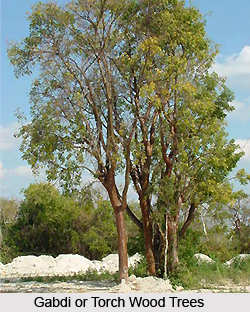 Gabdi or Torch wood tree is recognised in the world of science by the botanical name of Cochlosperma ceae Cochlospermum religiosum (L.) Alson. This plant is given various names by the people of different states. The people of West Bengal know this plant by the name of `Gabdi` , the residents of Gujarat name this plant `Ganeri`, the people of Maharashtra call this plant by the name `Gangeri` and the people of Orissa call it `Bendia murdoni`. This plant is recognised as `Adaviburaga` in Kannada, `Appakudakka` in Malayalam, `Kumbi` in Punjabi , `Kongillam` in Tamil, `Kondagogu` in Telugu and `Katira` in Urdu.
Gabdi or Torch wood tree is recognised in the world of science by the botanical name of Cochlosperma ceae Cochlospermum religiosum (L.) Alson. This plant is given various names by the people of different states. The people of West Bengal know this plant by the name of `Gabdi` , the residents of Gujarat name this plant `Ganeri`, the people of Maharashtra call this plant by the name `Gangeri` and the people of Orissa call it `Bendia murdoni`. This plant is recognised as `Adaviburaga` in Kannada, `Appakudakka` in Malayalam, `Kumbi` in Punjabi , `Kongillam` in Tamil, `Kondagogu` in Telugu and `Katira` in Urdu.
The Indian medicinal plant Gabdi or Torch wood tree, is originated from central and southern India. This tree commonly grows in profusion in dry forests, especially on rocky slopes throughout peninsular India. This plant, Gabdi is less common in western coastal districts. It is a small deciduous tree that grows up to 7.5 metre tall and has a smooth, deeply furrowed, fibrous and ash grey bark
Leaves of this medicinal plant are alternate, palmately 3 to 5 lobed, 7cm to 22cm long and 5cm to 1 cm wide, apex is acuminate with a blunt tip. The base is acute, above is glabrous and tomentose beneath. The petioles are usually 10cm to 18cm long. The stipules are linear and 5mm to 7mm long. Flowers are bright yellow in colour, 7cm to 13cm in diameter in terminal panicles with tomentose peduncles. The pedicels are stout, 5cm to 13cm long, grooved and twisted and pubescent. The sepals are unequal, oblong, concave and the outside is silky. The petals are obovate, and deeply emarginate. The flowers appear before the new leaves. Fruit is 5 cm to 7.5 cm long, obovoid, striate outside and five valved. The fruits carry 5.5 mm longseeds that are covered with white silky wool. The Gabdi tree generally bears flowers between January and April and fruits get ripen between March and July in central India.
The Gabdi or Torch wood tree is an Indian medicinal plant and is highly desired for its medicinal properties. The gum transuded from the cut bark of this tree is considered sweetish, cooling, stomachic and sedative. This gum , in Unani medicine , is used to treat gonorrhoea, syphilis, asthma, eye troubles and trachoma, and cosmetically to soften skin. This oozed gum is also used to relieve coughs. The dried leaves and flowers of Gabdi tree are used as stimulants in Punjab.











